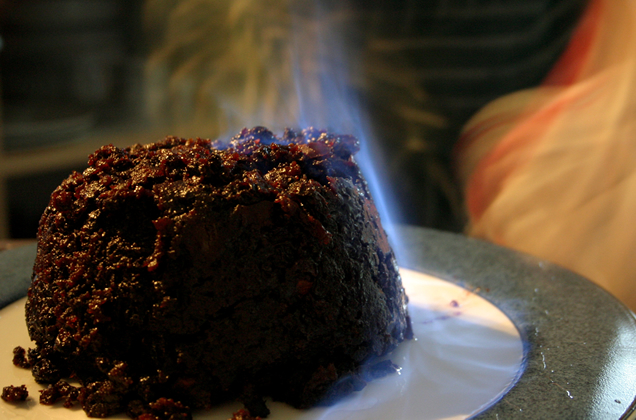Christmas, at least in my country of birth, is a time for eating and eating big. Many mainland European countries have their main festive meal on December 24, Christmas Eve. In the UK, however, it’s December 25, the big day itself and people go absolutely nuts, heaving vast swathes of food onto already groaning tables. Traditionally, the food was always goose or, if the household had plenty of money, peacock, swan or a roasted boar’s head. Naturally, around the time of the introduction of the turkey to the UK (circa 1520) the majority of the population didn’t have the wherewithal to display a swan in the centre of the table.
The unfortunate turkey became popular for two reasons – it was not expensive and it gave more meat than the scrawny chicken strutting around in those days. No British Christmas would be complete without a Christmas pudding, a heart attack waiting to happen. The pudding is usually made well in advance to allow it to mature and contains beef fat, sugar, spices breadcrumbs, cognac, flour and kilos of dried fruit. It’s flambéed before eating, adding another alcoholic dimension to the proceedings. If that doesn’t kill you, the coin secreted in the pudding for good luck might just do for you.
If all that sounds a bit much, you could always spend Christmas in a Scandinavian country but don’t expect them to go easy on the booze. Beer and aquavit are all traditional parts of the repast, as is the ubiquitous glögg, a warmed wine drink made with spices and fruit. It may seem innocent enough but make sure you trust the person who made it. I’ve seen rum, vodka and whiskey all stirred in by enthusiastic party hosts. In Denmark, the tradition was once roast pork with potatoes, red cabbage and gravy. But goose is now becoming the centrepiece of choice – odd for a country whose GDP is highly pork-related. For pudding the Danes and the Swedes plump for rice pudding. It goes by a variety of names, including risalamande, the more French riz à l’amande or julgröt. In all cases, a peeled almond is hidden inside and whoever gets it is entitled to a special gift.
Lithuania, just across the water from Sweden couldn’t be more different. Their Christmas dinner, held on Christmas Eve, is very traditional and a fairly austere occasion if done properly. They make up for it by extending the frivolities until twelfth night, so it’s not all bad news. Hay is spread on a table before it is covered with a white table cloth, symbolizing the birth of Christ in a manger. Places are set, including settings for people who can’t make the meal, or who have died in the past year, as it’s believed that the spirit of the person will join the feast.
When the first star appears in the sky, the ceremonial meal begins. There are twelve dishes, representing the number of apostles (or months in the year), and they may contain no meat or dairy and must not be hot. Fish is allowed, with eel and herring popular choices. These are accompanied by hard biscuits and poppy seed milk, beet soup and roasted or boiled potatoes. The only alcohol allowed is home-made cider. It’s considered unlucky to not try at least some of every dish but worse yet, if you leave the table while someone else is still eating, you’ll be the first at the table to die, which seems harsh if you really need the toilet.
Saving the best for last, let’s have a look at Japan. Given that around 98% of people are Shintoist or Buddhist, if they have a religion, Christmas lunch is a big deal. Is it udon noodles? Sushi? Teriyaki? No, you’ll be guessing all day. It’s KFC. Yes, the Colonel is busy on Christmas Day, which isn’t a national holiday in Japan. Kentucky Fried Chicken is the go-to meal, with a family bucket costing around €25, complete with chocolate cake. Some KFC joints are so popular, customers order their Christmas lunch a month or two in advance, or will queue for up to two hours to get it.
Christmas cake is also hugely popular but not the booze-laden European dried-fruit fest. Huge, cream-filled and cream-topped pillows of cake with fresh fruits are consumed on the 24th, giving rise to the now outdated expression that a young woman over 25 and unmarried was a ‘Christmas Cake’ or no good after the 25th. For the Japanese, it’s all about cake and chicken, not religion.
When you think about it, none of this is any stranger than stuffing money into puddings, dragging a perfectly healthy tree indoors to die or leaving food out for the big guy and his reindeer.







